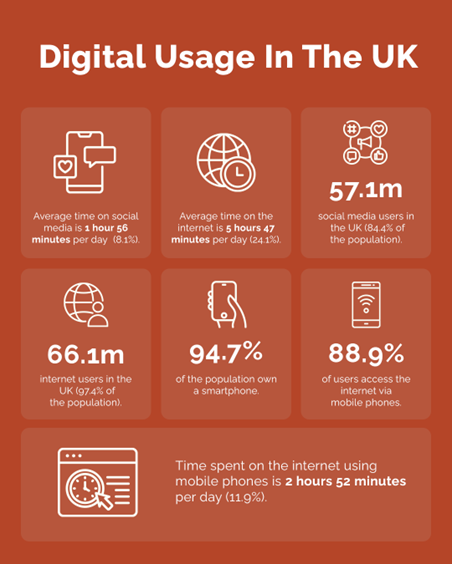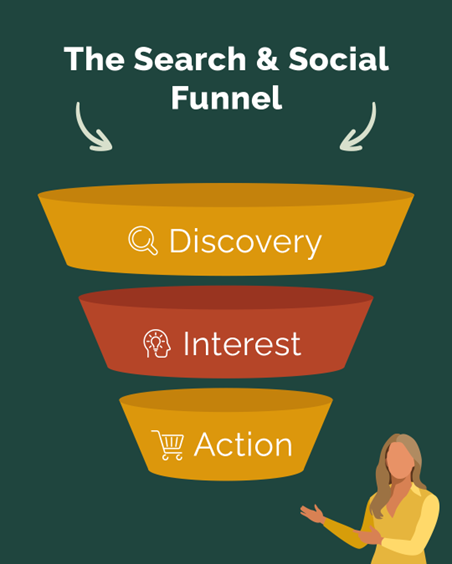It is no secret that Google and Meta aren’t the best of friends. The two tech giants were both innovators of search and paid social marketing respectively, and the similarity of some of their ad products has meant that they’ve been seen as adversaries for a long time. Despite this, the companies boast a duopoly of the digital advertising space, turning over billions of pounds in ad revenue every year.
As digital marketers, our solutions are always driven by the business objectives of our clients. Often, these don’t necessarily sit with one of Meta and Google, but both. So the question is, how do we get Search & Social to work alongside each other to deliver performance?
Say hello to your platforms
As a market, the UK is responsible for 4% of Google’s global traffic. Paid search activity involves shopping results, sponsored search ads (based on keyword bidding), display ads and video activity on YouTube. Search ads are designed so that brands can capitalise on user intent, and our challenge is that customers see the ads at the right place and at the right time. The ads work on an auction-based cost-per-click (CPC) model, charges as users click on the ads they’ve been served. Even though the cost of living crisis has impacted the spending habits of Britons, the amount of money brands are spending on search ads is up by 13% year-on-year, with the industry being worth an eye-watering £13.14bn in the UK alone.
Social shopping has broadened over the past few years, with Meta’s Facebook & Instagram being forced to share a slice of the pie with highly intentful search and discovery platforms such as Pinterest, and increasingly, TikTok. However, Meta still dominates the social commerce space according to PayPal’s e-Commerce Index, with Facebook and Instagram leading the way in purchase volume (40%). In the same report, 44% of UK consumers admitted to having made a purchase through social platforms, and 18% made weekly or frequent purchases. Similarly to Google, the cost-of-living crisis doesn’t seem to have filtered down to social shopping behaviour, with Brits ranking third in Europe for average monthly social shopping spend (£107).
What is the opportunity for brands with PPC and Paid social marketing?
There are 66.1m Brits on the internet, roughly 97.4% of the population, and 94.7% of the population own a smartphone. With internet access so easy for most of us, the digital marketing space has plenty of opportunity to flourish. The average Brit spends 2 hours and 52 minutes per day on the internet on their mobile phones. For marketers, this means that there are almost 180 minutes of attention to fight over.

Source: We Are Social/Meltwater’s Digital 2023 Report
The amount of internet use per day means that brands need to spread their budgets across different platforms to reach consumers at multiple touchpoints. According to Google themselves, the average user journey includes 5 separate channels and can take 2.7 days to decide. Think of the moments of your day when you use your phone, do you use it only to search on Google, or watch videos on YouTube? Probably not! We see you scrolling there on Facebook, Instagram, TikTok, Pinterest and others too.
Data from Insider Intelligence reveals that digital efforts affect in-store purchasing too, with 33% of consumers researching products on Google before buying and 13% having seen the product on social media. In our client data, we have seen on GA4 that 15% of impressions are coming from YouTube/social awareness efforts.
The reality is that brands need a strategy that incorporates different platforms within the marketing mix to be successful through the power of repetition. If you are reaching a customer across multiple touchpoints, such as Google, Meta, TikTok, YouTube and Pinterest, the likelihood is that your brand and/or products will be top of mind when it comes to purchasing decisions.
For brands to capitalise on this, it’s essential that search and social work in conjunction with a seamless user experience. This includes having joined up creative and copy, so the audience feels reassured by brand familiarity. A consistent ad experience will inspire purchases, with Google data showing that 47% of consumers in the UK will purchase from a brand they haven’t previously if they inspire confidence.
How PPC and Paid Social services can work together to drive performance?
The good news is that between search and social, there are lots of different ad types that fit together in all phases of the funnel. These can be used in conjunction to connect the various funnel phases, meaning that you’re able to support an ad strategy with multiple touchpoints.
Discovery
Channels: TikTok, Meta, YouTube, Display, Pinterest
In the discovery phase, we look to reach a broad audience of potential customers with messaging that introduces them to a brand or product. On social, this can be through branded video content/imagery, or influencer marketing. Essentially, we want to pitch ourselves as a viable solution for our broad audience and the key here is reach and frequency. Controlling the number of times the audience sees the content gives long-term brand and sales uplift, as well as prevents fatigue with certain messages.
Creatively, we adopt a test-and-learn method to inform our design choices for the ‘Interest’ and ‘Action’ phases of the funnel. Due to the broadness of the audience, we can show off a variety of products and/or ranges and trust platform algorithms to serve the right creative at the right time to the right person.

For search marketing on YouTube, we adopt a similar approach to social. Here, we can tell brand stories over a shorter or longer period due to the different types of ads that are accepted. In an ideal world, our ads will be served in a 6-second or 15-second non-skippable format, meaning we have the undivided attention of the audience. However, longer formats (30+ seconds) allow us to tell the brand story in more detail.
For display ads, we lean into the audience’s browsing interests to serve ads on websites that are similar to our product or service. Using a running brand as an example, ads for our new range of running wear may feature on a running blog. Even though these ads are clickable, they’re also action-provoking, meaning audiences may conduct searches of their own after seeing the ad on a website.
Even though the search and social funnels aren’t necessarily connected in this phase, we are nurturing potential customers by pitching to them across multiple touchpoints.
Interest
Channels: TikTok, Meta, Google Search, Google Shopping, Pinterest
Here is where we start to see our joined funnel begin to intertwine. Through the awareness activity, we will see people from search and social that have browsed the website to discover more. On both search and social, the ad platform pixels will trigger once a user lands on the site, no matter where they’ve come from. This allows us to capture site behaviour data and we can use the respective platforms to be able to ringfence it.
On social in this phase, it’s best to group site behaviour generically, instead of by precise actions. Grouping all of those who landed on the website allows us to nurture these potential customers further, whilst keeping a wide enough net of people to target. As well as this, social platforms allow us to group audiences by in-platform behaviour. We can group those who have engaged with our awareness ads to market to a warm audience.
On Google, paid search and shopping usually perform best in the ‘Interest’ and “Discovery’ phases. The awareness activity in the ‘Discovery’ phase across social and search also gives a boost to organic brand/focused search as the audience seeks to get more information from the ads they’ve already seen, and this is where search marketing on brand terms will thrive.
Action
Channels: TikTok, Meta, Google Search, Google Shopping, Pinterest
The ‘Action’ phase is all about maximising the opportunities presented by customer intent. Both search and social platforms come into their own respectively at this stage, by leveraging previous campaign data.
On social, the intent is signalled through the behaviour registered by the pixel. Here, we can re-market dynamically to people who have viewed specific products to create a tailored ad experience on social platforms. As well as this, we can group audience members by action, to create an approach that fits in seamlessly with their journey. For example, if a customer has added a product to their cart but has not purchased it, we can serve them an ad showing the product they’ve added with a reminder to purchase before it’s gone.
On Google, paid search is ideal for capturing and converting intent, delivering a high ROI as marketers can target tightly, and spend where the results are best. Marketers can bid on brand as well as long-tail search terms in this phase, as the audience is searching with a specific intent that is easy to predict given the fact the audience has been exposed to controlled campaign messaging and specific products.
As well as this, re-marketing is key in increasing conversions on search, too. Re-marketing on search is similar to paid social, with an audience being built of actions and inactions before ads are served up to potential customers whom we failed to close the deal with. Google offers a few different ways of doing this, which boil down to remarketing to people with text ads on the search engine results page (SERP) or by using some form of rich media on the wider Google Display Network (GDN), which includes Discovery, Gmail and YouTube even if they’re not quite the same behaviour. We describe this as active re-engaging, which increases impressions and lowers proportional engagement metrics (CTR, conversion rate etc.)
If an integrated, multi-touchpoint approach is something that you need help implementing or would like to discuss in more detail, get in touch with our team of PPC and paid social experts today.